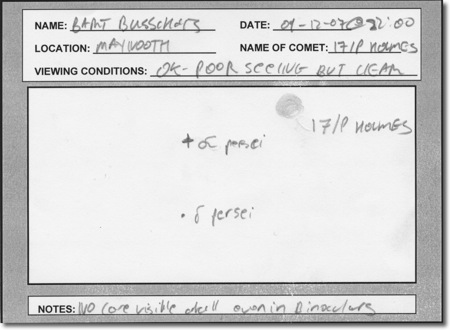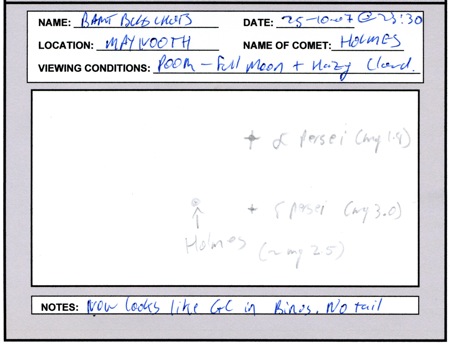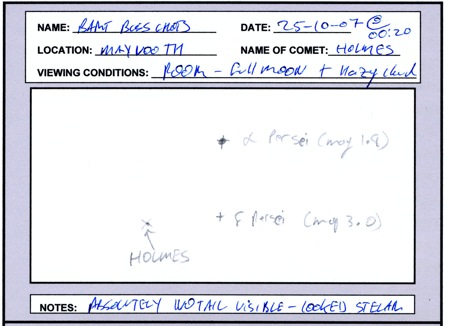Dec
10
17/P Holmes Still Naked Eye Object
Filed Under Science & Astronomy on December 10, 2007 | Leave a Comment
Amazingly comet 17/P Holmes is still visible to the naked eye under good conditions. When it flared up way back in October no one dared predict it would remain visible for more than a week or two. The comet has changed a lot in appearance over the last month and a half though. It started out looking like a star and is not a massive and very diffuse blob which appears as big as, if not bigger than, the Moon. This new defuse character means that the comet is rendered invisible by any Moon light, haze or high cloud. Having said that I did manage to glimpse it last night from my back garden in Maynooth so it can stand a little light pollution when it is very high up in the sky (it was nearly over head when I observed it last night). I can’t imagine this fascinating comet will still be visible one Moon cycle from now so make the most of the next few days to grab it before the Moon comes in to spoil the fun again, and probably for good this time!

[tags]Comet, 17/p Holmes[/tags]
Nov
9
Comet 17/P Holmes Update
Filed Under Science & Astronomy on November 9, 2007 | Leave a Comment
With the Irish weather being what it is it’s been quite a while since I’ve managed to get a good look at the periodic comet Holmes. Since my last post about the comet I managed to observe it just twice, once on the 28th of October, and this evening. I didn’t bother posting on the 28th because conditions were poor and not much had changed since my last post. However, today, I got to observe the comet with good observing conditions.
[tags]Comet, 17/P Holmes[/tags]
Oct
26
Comet 17/P Holmes Observed Again
Filed Under Science & Astronomy on October 26, 2007 | 8 Comments
After yesterday’s surprise outburst comet 17/P Holmes continues to put on a great show. This object is highly dynamic and you can watch it move day-to-day with just the naked eye. Between yesterday and today the comet has moved noticeably closer to the star Alpha Persei and has also definitely brightened. Yesterday Holmes and the star Delta Persei looked to be the same brightness, today the comet is definitely brighter than the star. I’d estimate it’s brightness at about Magnitude 2.5.
I’ve been following the comet with my trusty 10x50mm binoculars and the changes are even more spectacular through them. Yesterday Holmes looked like a star, a point of light with no noticeable coma or tail. Today, it looks like a compact globular cluster with a bright core. Yesterday I didn’t really notice a colour buy today it’s clearly yellow. I’ve never seen an astronomical object change so much so quickly. I hope we get to watch this fascinating object evolve for a few more days to come, however, the weather forecast for us here in Ireland is not looking good :(.
I’ll leave you with a scan of my record of today’s observation of the comet:

[tags]Astronomy, Comet, Holmes[/tags]
Oct
25
Surprise Outburst of Comet Holmes Observed
Filed Under Science & Astronomy on October 25, 2007 | 6 Comments
It’s very rare to get to see a comet which is so bright that you can easily see it from the middle of a housing estate through light haze with a near full Moon with just your eyes. No telescope, no binoculars, nothing! But that’s what I’ve just done. The Periodic comet 17/P Holmes has just surprised the heck out of Astronomers by brighting from Magnitude 17 (you need a professional grade telescope to see things that faint) to Magnitude 3 (easily visible with the naked eye) literally over-night. Obviously something very spectacular just happened on the comet.
Thanks to an email with coordinates form Terry Mosley I knew Holmes could be found near delta Persei at around midnight. When I got outside conditions were very poor and not helped by the street lights all around me. As I mentioned there was a near full Moon high to the south and a think layer of haze across the whole sky being lit up by the Moon. Needless to say my expectations weren’t high. However, Holmes was so bright that it distorted the shape of Perseus to the extent that I had trouble finding the constellation! My brain just kept saying “no, that’s not Perseus, Perseus doesn’t have that nice little triangle of stars in it”. You guessed it, one of those three stars was not a star at all but the comet. To me Holmes looked to be about the same brightness as Delta Persei so that would put it at around the Magnitude 3. I’ve never seen a comet like this before. It looks just like a star, even in binoculars. No Coma, no tail, nothing, just a point of light. For all the world it looks like an extra star has appeared out of nowhere in Perseus. I’ve attached a scan of my record of the observation below.

If you’re interested in observing the comet yourself the guys in Astronomy Ireland have been kind enough to put a finder chart up on their website. You can find it here: www.astronomy.ie/holmes2.gif
[tags]Comet, 17/P Holmes[/tags]
May
20
A Good Night for Observing Planets
Filed Under Science & Astronomy on May 20, 2007 | Leave a Comment
Having set myself the challenge of observing all the planets with a pair of 10x50mm binoculars I bought in Lidle for €19 this year I got to tick another one off my list today, Jupiter. I now just need Mars and the two difficult ones, Uranus & Neptune. Although Jupiter is the only one I get to cross off my list today I did get to observe many more planets, in fact, I observed all the planets bar the three I’m missing!
Mar
4
Yesterday’s Total Lunar Eclipse
Filed Under Science & Astronomy on March 4, 2007 | 1 Comment
I observed the eclipse from the end of the umbral phase when you could start to see some limb darkening through to the middle of totality. There were three of us to start with, myself, my better half and a mate, but since I set the telescope up in the driveway we soon had a collection of passers by having a look through the telescope and the binoculars and we wowed a few of the more interested ones with a quick glance of Saturn. One of our neighbors came round for a few looks and brought us some beers as a thank you (cheers Michael, much appreciated). All in all it was a good observing session and the things that we noticed were:
- That there was a blue tint on the edge of the umbral shadow
- That even during maximum eclipse the moon wasn’t very red, more orange
- That even during maximum eclipse we could easily make out the larger seas with the naked eye, with binoculars loads of surface features were easily visible, and with the telescope even lunar rays were easy to see.
- The top edge of the moon was always that bit less dark than the rest.
This would lead me to the conclusion that this eclipse was at point 4 on the Danjon scale, i.e. the least dark kind of lunar eclipse. The fact that the earth didn’t pass through the center of the Moon’s shadow probably played a part in this as did the fact that we’ve had no major volcanic activity recently.
All in all it was a great nights observing with no real weather problems, we had the occasional whisp of high cloud but they passed by very quickly. The most important thing was that a good night was had by all.
Feb
4
Bart’s Planet Challenge 2007 – The Beginning
Filed Under Science & Astronomy on February 4, 2007 | 3 Comments
One of the things that occoured to me when Pluto got re-classified was that it is now possible to see all the planets in our solar system with nothing more expensive than a 19 Euro pair of binoculars from Lidel. So, this year my challenge to myself is to do just that, observe all the planets with nothing more than my 10×50 binoculars. Venus, Mars, Jupiter and Saturn will be very easy, the others will be more tricy. Mercury, because it spends so much time so close to the Sun that you are dependent on a clear western horision some time you can actually get out to see it within a few short windows each year, and Uranus and Neptune because they’ll require the binoculars to see. If you’re a beginner this is a very good challenge to help you get to know the sky and to become adept with your binoculars and/or telescope. I’d strongly advice you give this a go.
Nov
1
Comet SWAN Appears to be Dimming
Filed Under Science & Astronomy on November 1, 2006 | Leave a Comment
I got my first good look at the comet SWAN in a few days today and it was far from impressive. Matters were not helped by the fact that a 60-70% full moon was high in the sky but seeing was perfect so I was still expecting a good show. SWAN has moved quite a distance away from M13 at this stage so comparisons are getting harder but the comet is definitely dimmer than it was on October 27th. Then the comet was significantly brighter than M13 (mag 5.9) whereas today SWAN appeared to be somewhat dimmer than the cluster. To try get a more accurate estimate of the magnitude I jotted down the star field and then looked for a star that was about the same brightness as the comet when de-focused to the same size as the comet. There were two bright (in binoculars) stars near the comet, SAO 85028 (mag 6.3) and SAO 85001 (mag 5.6). The comet was definitely dimmer than SAO 85001 and looked to be very very similar in brightness to SAO 85028. This leads me to estimate the magnitude at between 6.0 and 6.5 with 6.3 being my best estimate.
[tags]SWAN, Comet, Astronomy[/tags]
Oct
27
Comet SWAN Brightens Significantly
Filed Under Science & Astronomy on October 27, 2006 | Leave a Comment
Until today I hadn’t been able to observe the comet SWAN since the 12th of October because of the Irish weather. The last time I observed it the comet was rather low in the sky and easily visible in binoculars but definitely not a naked-eye object. Today I managed to observe the comet again twice, once before the sky was fully dark and then again when it was properly dark. The comet has moved significantly and is now a lot higher in the sky in the constellation of Hercules but what really struck me was how much it had brightened.
[tags]Comet, SWAN[/tags]
Oct
12
Comet SWAN Observed
Filed Under Science & Astronomy on October 12, 2006 | 1 Comment
That’s two clear nights in a row! I’m just in the door after another very successful observing session but unlike yesterday this one was not form the darkness of rural Ireland but from the light-polluted suburbs of Dublin (Maynooth to be precise). My target for today was the comet SWAN and also to try to track down M92 which I’d missed yesterday.
[tags]SWAN, Comet[/tags]






